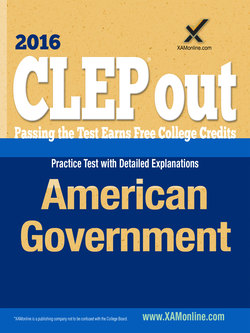Читать книгу CLEP American Government - Sharon A Wynne - Страница 3
AMERICAN GOVERNMENT
ОглавлениеDescription of the Examination
The American Government examination covers material that is usually taught in a one-semester introductory course in American government and politics at the college level. The scope and emphasis of the exam reflect what is most commonly taught in introductory American government and politics courses in political science departments around the United States. These courses go beyond a general understanding of civics to incorporate political processes and behavior. The exam covers topics such as the institutions and policy processes of the federal government, the federal courts and civil liberties, political parties and interest groups, political beliefs and behavior, and the content and history of the Constitution.
The examination contains approximately 100 questions to be answered in 90 minutes. Some of these are pretest questions that will not be scored. Any time candidates spend on tutorials and providing personal information is in addition to the actual testing time.
Knowledge and Skills Required
Questions on the American Government examination require candidates to demonstrate one or more of the following abilities in the approximate proportions indicated.
Knowledge of American government and politics (about 55%–60% of the exam)
Understanding of typical patterns of political processes and behavior (including the components of the behavioral situation of a political actor), the principles used to explain or justify various governmental structures and procedures (about 30%–35% of the exam)
Analysis and interpretation of simple data that are relevant to American government and politics (10%–15% of the exam)
The subject matter of the American Government examination is drawn from the following topics. The percentages next to the main topics indicate the approximate percentage of exam questions on that topic.
30%–35% Institutions and Policy Processes: Presidency, Bureaucracy, and Congress
The major formal and informal institutional arrangements and powers
Structure, policy processes, and outputs
Relationships among these three institutions and links between them and political parties, interest groups, the media, and public opinion
15%–20% Federal Courts, Civil Liberties, and Civil Rights
Structure and processes of the judicial system with emphasis on the role and influence of the Supreme Court
The development of civil rights and civil liberties by judicial interpretation
The Bill of Rights
Incorporation of the Bill of Rights
Equal protection and due process
15%–20% Political Parties and Interest Groups
Political parties (including their function, organization, mobilization, historical development, and effects on the political process)
Interest groups (including the variety of activities they typically undertake and their effects on the political process)
Elections (including the electoral process)
10%–15% Political Beliefs and Behavior
Processes by which citizens learn about politics
Political participation (including voting behavior)
Public opinion
Beliefs that citizens hold about their government and its leaders
Political culture (the variety of factors that predispose citizens to differ from one another in terms of their political perceptions, values, attitudes, and activities)
The influence of public opinion on political leaders
